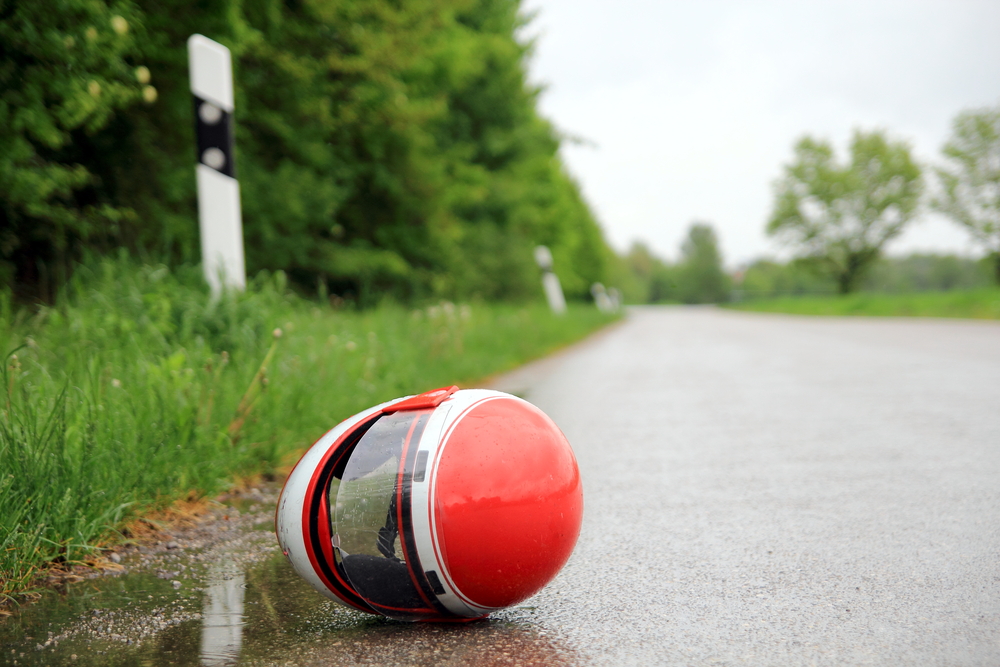As a biker, knowing the most common types of motorcycle accident injuries can help you accurately describe what you’ve suffered after a crash. That, in turn, will make it easier to get effective medical treatment and appropriate compensation when you file an insurance claim or lawsuit.
Additionally, Hiring an attorney is essential in navigating the legal complexities of securing fair compensation. An experienced Chicago motorcycle accident attorney can guide you through the legal process, and work to ensure that you receive a fair compensation for the damages incurred in a motorcycle accident.
Why Are Motorcycle Accidents So Dangerous?
Motorcycle accidents are particularly dangerous and often lead to serious or fatal injuries for several reasons:
Motorcycles Offer Less Protection

In an accident, a car’s cabin can act as a protective barrier between the driver and external impacts. Motorcyclists’ direct exposure makes them vulnerable to collisions with other vehicles and contact with objects like road barriers, poles, or even the road surface itself.
In high-speed crashes, this type of direct impact can lead to severe injuries or fatalities, especially if the crash throws the motorcyclist from their vehicle.
Motorcycles Are Less Stable
The stability of motorcycles is another critical factor that contributes to their danger. Motorcycles have only two wheels, which inherently makes them less stable than four-wheeled vehicles like cars.
This two-wheeled design is particularly hazardous in poor road conditions – such as wet or icy roads – or in adverse weather conditions like rain or strong winds.
Under these circumstances, motorcycles are more likely to slide, skid, or topple over. Even experienced riders find it challenging to maintain control in these situations, leading to a higher risk of accidents and resultant injuries when conditions are bad.
Motorcycles Are Harder to See
Motorists sometimes have a hard time seeing nearby motorcycles due to their smaller size, which also makes it harder to gauge their relative speed and distance.
The presence of other vehicles, road signs, or environmental factors like darkness or rain can easily obscure motorcycles and their riders. This reduced visibility is particularly problematic in heavy traffic or during night-time riding.
Other drivers might cause collisions if they fail to notice a motorcycle near them or misjudge its speed and distance. These accidents are often severe because they usually involve larger, heavier vehicles striking the motorcycle.
Protective Gear Only Goes So Far
While protective gear like helmets, jackets, gloves, and boots can significantly reduce the risk of injuries, they have limitations. Helmets are essential for protecting against head injuries and are highly effective in many scenarios.
However, in high-speed impacts or collisions with larger vehicles, the force of the crash can exceed what the protective gear can handle. In such instances, the rider might still suffer major injuries.
Helmets and protective gear can reduce the severity of an injury but cannot completely eliminate the risk, especially in serious accidents.
Common Types of Motorcycle Accident Injuries
Motorcycle accidents can result in a broad spectrum of injuries. The severity and type of injury depend on factors like the speed at the time of the accident, whether the rider wore protective gear, and the nature of the collision. Below are some common examples of crash injuries affecting motorcycle riders.
Road Rash

Traumatic Brain Injuries
Traumatic brain injuries (TBIs) can occur in motorcycle accidents if the rider’s head hits an object or the ground. Even with a helmet, the brain can suffer injury from a strong impact force.
TBIs can range from mild concussions to severe, life-altering brain damage. Symptoms include headaches, confusion, dizziness, and, in severe cases, loss of consciousness or memory problems.
Spinal Cord Injuries
Spinal cord injuries from motorcycle accidents are potentially life-changing. These injuries result from a forceful impact or penetrating injury damaging the spinal cord and interrupting the flow of signals between the brain and the rest of the body.
It can lead to partial or complete paralysis, depending on where the damage occurs along the spine and how severe it is.
Whiplash
Whiplash occurs when the head and neck suddenly jerk forward and backward, making it particularly common in rear-end collisions. Motorcycle riders can suffer whiplash if they stop abruptly or if other drivers hit them from behind. Symptoms include neck pain, stiffness, headaches, and dizziness.
While many assume whiplash to be less severe than other injuries, it can still cause long-term discomfort that requires ongoing therapy.
Internal Bleeding
Internal bleeding can happen when riders sustain high-speed impact injuries in motorcycle accidents. It’s a serious condition in which blood vessels sustain damage and begin leaking blood inside tissues, organs, or cavities.
Symptoms often do not appear immediately but can include abdominal pain, dizziness, weakness, and shock.
Bone Fractures
Bone fractures are common in motorcycle accidents when riders fall or suffer blunt-force impacts. Riders commonly break bones in their arms, legs, ribs, and pelvises.
Fracture severity can vary from simple breaks, which might heal with a cast, to compound fractures, where the bone breaks through the skin, causing a secondary injury. Treatment typically involves immobilization with a cast or splint and sometimes surgery.
Shoulder Dislocations
Shoulder dislocations involve the arm bone popping out of the shoulder socket. This injury is common in motorcycle accidents when a rider falls and lands on their arm or shoulder.
Symptoms include severe shoulder pain, inability to move the arm, and a visibly out-of-place shoulder. Treatment involves putting the bone back in place, often followed by physical therapy to strengthen the shoulder muscles.
Soft Tissue Injuries
Soft tissue injuries include damage to muscles, tendons, and ligaments. In motorcycle accidents, these injuries often result from blunt force trauma. Common symptoms include pain, swelling, and bruising. While they might seem less severe, soft tissue injuries can cause chronic pain and require costly long-term care.
Bruises and Lacerations
Bruises and lacerations are common in motorcycle accidents. Also called contusions, bruises happen when small blood vessels break under the skin, causing discoloration and pain.
Lacerations are deep cuts or tears in the skin, often resulting from direct contact with sharp objects during a crash. Both injuries can range from minor to severe.
Dental Injuries
Dental injuries in motorcycle accidents can include chipped, broken, or lost teeth and damage to the jaw. These injuries can occur if a rider’s face hits the ground or another object, resulting in pain and bleeding in the mouth and difficulty eating or speaking. Treatment might involve dental surgery or restorative dental procedures.
Face and Eye Injuries
Face and eye injuries from motorcycle accidents are often severe, ranging from cuts and bruises to serious damage to the eyes or facial bones. These injuries often occur when debris like gravel or glass hits the rider’s face. They can also result from direct impacts with other vehicles or objects in a crash.
Symptoms can include pain, swelling, vision problems, or bleeding. In severe cases, face and eye injuries can result in permanent blindness or disfigurement.
Neck and Back Injuries
Neck and back injuries in motorcycle accidents can be particularly serious, involving strain to muscles and ligaments or even damage to the spine. The consequences of neck and back injuries range from pain and stiffness to paralysis in severe cases.
Chronic pain resulting from neck and back injuries often requires extensive treatment, possibly including surgery and physical therapy.
Joint Injuries
Joint injuries, such as sprains or dislocations, occur frequently in motorcycle accidents. These injuries are especially common in the knees, elbows, and shoulders. They happen when strong forces push a joint out of its normal position.
Symptoms include pain, swelling, and difficulty moving the joint. Treatment usually involves rest, ice, compression, and elevation. In more severe cases, physical therapy or surgery might be necessary.
Arm and Hand Injuries
Collisions often throw riders off their bikes, and the natural instinct to use one’s arms to brace for an impact increases the risk of injuries to the upper extremities. Arm and hand injuries are often debilitating and sometimes prevent riders from returning to work after a crash.
Leg and Foot Injuries
Common leg and foot injuries in motorcycle accidents include fractures, sprains, and cuts. Riders might suffer these injuries if their bikes fall on them during the collision or if the force of impact throws them off the bike.
Some riders also sustain leg and foot injuries when other vehicles or objects pin and crush them upon impact. Treatment for these injuries might involve wearing a cast, using crutches, or even undergoing surgery in severe cases.
Pelvic Injuries
Pelvic injuries in motorcycle accidents often occur due to direct impacts on the lower body. These injuries can range from pelvic fractures to internal organ damage. Riders with pelvic injuries commonly experience severe pain, difficulty standing or walking, and swelling in the pelvic area.
Amputations
When a collision damages a limb severely enough, doctors may have to amputate it. These tragic injuries can happen during high-impact crashes or if a bike or other vehicle crushes a rider’s limb.
In some cases, the force of a collision is so extreme that it separates a limb from the rider’s trunk without any surgical intervention. Recovery from an amputation is challenging and often requires physical therapy and learning to use a prosthetic limb.
Burns
Burns can affect motorcycle riders in accidents if a bike’s hot engine or exhaust pipes come into contact with the rider’s skin. Burn injuries can range from first-degree burns, which are similar to a sunburn, to third-degree burns, which are more severe and damage deeper layers of skin.
Treatment for burn injuries depends on the severity and often includes applying burn ointments, taking pain medication, and, in severe cases, receiving skin grafts.
Post-Traumatic Stress Disorder (PTSD)

Why You Need a Lawyer if You Suffer Injuries in a Motorcycle Accident
Hiring a lawyer is a critical step to pursuing justice after a serious motorcycle accident. Motorcycle riders often face unfair biases when filing accident claims.
Many people incorrectly assume that motorcyclists are inherently reckless and generally at fault in accidents. This bias can affect how insurance companies and juries view your claim and their willingness to compensate you fairly.
Calculating the true cost of injuries is often more difficult after a motorcycle accident, too. Motorcycle riders are more likely to suffer a range of severe injuries and incur extensive medical costs as the result of collisions.
A motorcycle accident lawyer can assess not just your current medical bills but also future medical expenses, lost earning potential, and the pain and suffering they entail. Without a lawyer, you might not know how to properly value these losses, meaning you won’t know whether an insurance settlement is fair or not.
A lawyer understands the challenges you face and knows how to overcome them. They can gather evidence to prove your side of the story and demonstrate that the driver who hit you is at fault.
This evidence might include witness statements, traffic camera footage, and cell phone records. They might even work with accident reconstruction specialists to create diagrams of the collision and establish liability.
Insurance companies often try to settle claims quickly and for less than what claimants deserve. Without a lawyer to stop them, they will attempt to take advantage of your lack of legal knowledge and get you to sign away your rights for pennies on the dollar.
A lawyer can negotiate with insurance companies on your behalf to demand the fair settlement you deserve. They know the tactics insurance companies use and how to counter them, providing peace of mind as you recover from your injuries.
